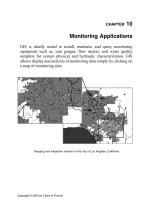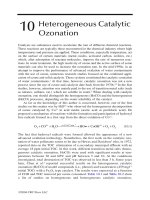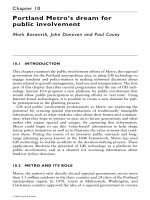Lecture Building reliable component-based systems - Chapter 10: Predicting system trustworthiness
Bạn đang xem bản rút gọn của tài liệu. Xem và tải ngay bản đầy đủ của tài liệu tại đây (223.48 KB, 16 trang )
Chapter 10
Predicting System Trustworthiness
Building Reliable Componentbased
Overview
Introduction
What else can be done?
Predicting component interoperability
Summary
Building Reliable Componentbased
Introduction
Functional Composability (FC) and functional
correctness:
FC is concerned with whether f(a) x f(b) = f(a x B) is
true.
These concerns stem from the problem of composing
"ilities".
Reliability
Safety
Security
Building Reliable Componentbased
The Problem
The problem stems from our inability to know a priori,
For example, that the security of a system composed of
two components, A and B, can be determined from
knowledge about the security of A and the security of B.
Why?
Because the security of the composite is based on more
than just the security of the individual components.
Building Reliable Componentbased
An Example
As an example, suppose that:
A is an operating system and B is an intrusion detection
system.
Operating systems have
authentication security.
some
level
of
built-in
Intrusion detection systems have some definition of the
types of event patterns that warn of a possible attack.
Thus, the security of the composition clearly depends
on the security models of the individual components.
Building Reliable Componentbased
The Example Continued
But even if A has a worthless security policy or flawed
implementation, the composite can still be secure.
How?
IF A has poor performance
THEN no one can log in
OR
IF A's security mechanism not reliable
THEN security is increased
While these last 2 examples are clearly not a desirable
way to attain higher levels of system security, both do
actually decrease the likelihood that a system will be
successfully attacked.
Building Reliable Componentbased
Another Example
A as an operating system and B as an intrusion
detection system,
AND We assume that A provides excellent security and
B provides excellent security,
WE MUST still accept the fact that the security of B is
also a function of calendar time.
So the question then comes down to: which "ilities", if
any, are easy to compose?
The answer is that there are no "ilities" easy to compose
and that some are much harder to compose than others.
Building Reliable Componentbased
What Else Can Be Done?
If a piece of software fails only once after 100 tests,
DO NOT calculate quantitative score based on the
result!
DO consider it to be the result of the testing.
Building Reliable Componentbased
Isolating Potential Contributors
Parties that have contributed software functionality
(whether COTS or custom) to the system.
Potential contributors to the system failure include:
Defective software components
Problems with interfaces between components
Problems with assumptions between components
Hidden interfaces and non-functional component
behaviors that cannot be detected at the component
level.
Building Reliable Componentbased
Interface Propagation Analysis
Interface propagation analysis (IPA):
Perturbs the states that propagate through the interfaces
that connect COTS software components to other types
of components.
Note that software fault injection is also a form of
accelerated testing.
Building Reliable Componentbased
Reliability Testing
Operational profile testing test-cases
Test for defects occuring in operational phase
Many insignificant experiments
Time consuming
Input
Component/System
Building Reliable Componentbased
IPA at Work
To modify the information (states) that components use
for inter-communication
write access to those states is required (in order to
modify the data in those states).
This is obtained by creating a small software routine
named PERTURB which replaces, during system
execution, the original output state with a different
(corrupted) state.
Input
Component A
Component B
Building Reliable Componentbased
PERTURB
An Example using:
double cos(double x)
…
if (cos(a) > THRESHOLD) {do something}
…
if (PERTURB(cos(a)) > THRESHOLD) {do something}
The value added by having a utility such as PERTURB
is, in general, dependent on how well PERTURB mimics
corruptions that the utility under consideration.
Building Reliable Componentbased
Technique 1
The first technique:
Involves the deliberate inversion of the operational
profile originally anticipated by the system designers.
This technique is most beneficial when the description of
the expected profile is accurate.
Inversed
operation
al profile
Input
Component/System
Building Reliable Componentbased
Technique 2
The second technique:
Is simply a combination of the previous technique with
IPA.
Inversed
operation
al profile
Input
This is a situation in which the software is operating in
an unusual input mode while being bombarded with
corrupt information.
Component A
Component B
Building Reliable Componentbased
Summary
Non-functional behaviors are difficult to handle in
composition
Ordinary (reliability) testing is not enough
SWIFI can be used for testing non-functional behaviors
IPA is a technique for predicting interoperability
IPA is not the answer, but a complement to other
(traditional) testing techniques
.
Building Reliable Componentbased









